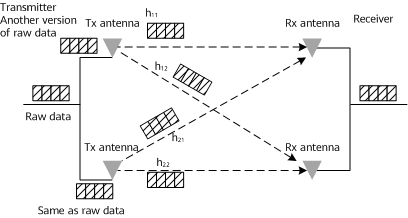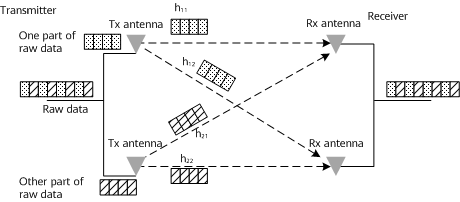What Is MIMO?
MIMO technology uses multiple antennas to transmit and receive signals in the wireless communications field. Mainly applied in the Wi-Fi (also known as WiFi) and mobile communications fields, this technology can greatly improve the system capacity, coverage range, and signal-to-noise ratio (SNR). In MxN MIMO, M represents the number of transmit (Tx) antennas and N represents the number of receive (Rx) antennas in a MIMO system.
From SISO to MIMO
SISO
Before going to MIMO, we need to have a glimpse at single-input single-output (SISO). Literally, SISO provides a unique path between the Tx and Rx antennas and transmits one signal. In a wireless system, each signal is transmitted over one spatial stream.

SISO implementation
Apparently, such transmission is unreliable and rate limited.
SIMO
To achieve higher reliability, single-input multiple-output (SIMO) is introduced. That is, one antenna is added on the receiver (STA), as shown in the following figure, so that two signals can be received concurrently.

SIMO implementation
As shown in the figure above, two signals containing the same data are sent from one Tx antenna. If one signal is partially lost, the receiver may still obtain complete data from the other signal. Although the capacity remains unchanged (still one path in use), the reliability is doubled. This mode is also known as receive diversity.
MISO
Now, let's move on to another idea. How about using two Tx antennas while retaining one Rx antenna?

MISO implementation
Given the presence of only one Rx antenna, the signals sent from the two Tx antennas must carry the same data and be combined as one signal on the receiver. This mode, referred to as multiple-input single-output (MISO) or transmit diversity, actually delivers the same effect as SIMO.
MIMO
The preceding analysis on SIMO and MISO proves that the transmission capacity depends on the number of Tx and Rx antennas. Therefore, using two antennas on both the transmitter and receiver can definitely double the rates by transmitting and receiving two signals separately. This mode of using multiple antennas on both the transmitter and receiver is MIMO.

MIMO implementation
MIMO technology enables multiple antennas to send and receive spatial streams (multiple signals) simultaneously and to differentiate the signals sent to or received from different spatial positions. By leveraging technologies such as spatial multiplexing and space diversity, MIMO boosts the system capacity, coverage range, and SNR without consuming extra bandwidth.
What Types of MIMO Exist?
MIMO technology uses multiple antennas to transmit and receive signals. It is initially used for single-user data transmission. However, with development of multi-user transmission technologies, several multi-user types of MIMO technology are derived from MIMO. For ease of distinguishing these MIMO modes, single-user type MIMO is referred to as single-user MIMO (SU-MIMO). The multi-user types of MIMO technology mainly include:
Multi-user MIMO (MU-MIMO): allows the transmitter to transmit data to multiple users concurrently. Wi-Fi 5 starts to support MU-MIMO with four users, while Wi-Fi 6 increases the number of users in MU-MIMO to eight.
Cooperative MIMO (CO-MIMO): combines multiple wireless devices into a virtual multi-antenna system, so that neighboring transmitters can transmit data to multiple users concurrently.
Massive MIMO: greatly increases the number of antennas. Traditional MIMO uses two to eight antennas, while massive MIMO supports up to 64, 128, or 256 antennas. This technology is a key technology for 5G mobile communications and significantly improves the system capacity and transmission efficiency.
In a broad sense, all multi-user types of MIMO technology can be classified as MIMO technology. However, when MIMO is mentioned, it usually refers to SU-MIMO.
How Does MIMO Work in Wi-Fi?
MIMO technology is introduced in the Wi-Fi 4 (802.11n) standard. MIMO is implemented mainly through space diversity and spatial multiplexing. Both of them are classified as space-time coding technologies for converting one channel of data into multiple channels of data.
Space diversity
Space diversity generates different versions of the same data stream so that the data stream can be encoded, modulated, and then transmitted on different antennas. The data stream may be a raw data stream to be sent or a new data stream as a result of certain mathematical transformation on a raw data stream. The receiver uses a spatial equalizer to receive signals separately and then performs demodulation and decoding to combine the signals of the same data stream and restore the original signals. Space diversity can transmit data more reliably.
Beamforming technology introduced in Wi-Fi 4 may also be considered a diversity technology. Beamforming detects the channel status and precodes the signals to be transmitted by each antenna so that the signals are superimposed and enhanced on the receiver. As such, this technology increases the signal transmission distance and improves the quality of signals received by the receiver.

Space diversity
Space diversity improves data transmission reliability and is applicable to long-distance transmission scenarios that do not require high rates.
Spatial multiplexing
Spatial multiplexing divides data to be transmitted into multiple data streams so that the data streams are encoded, modulated, and then transmitted on different antennas. This improves the transmission rates. Antennas are independent of each other. One antenna provides an independent channel. The receiver uses a spatial equalizer to receive signals separately and then performs demodulation and decoding to combine the data streams and restore the original signals.

Spatial multiplexing
Spatial multiplexing improves data transmission rates and is applicable to short-distance transmission scenarios with high rate requirements.
What Is MxN MIMO?
A WLAN device's MIMO capabilities are typically represented by MxN MIMO, where M represents the number of Tx antennas and N represents the number of Rx antennas in a MIMO system. For example, 4x3 MIMO indicates four Tx antennas and three Rx antennas.
Mainstream home wireless routers in the market have several antennas, each of which can transmit and receive signals. You can simply determine the values of M and N in MIMO based on the number of antennas. For example, a wireless router with four antennas can be considered a 4x4 MIMO router. The actual MIMO capabilities, of course, are subject to the product specifications. A device with more antennas provides higher performance and also costs higher.
Enterprise-level APs have more antennas and can provide faster and more reliable wireless networks for enterprises. For example, Huawei AirEngine 8760-X1-PRO — a flagship Wi-Fi 6 AP for enterprises — supports 4x4 MIMO on 2.4 GHz and 12x12 MIMO on 5 GHz. This AP has 16 antennas and supports a rate of up to 10.75 Gbit/s, delivering fiber-like wireless experience for users.
In a MIMO system, the number of available spatial streams depends on the number of Tx or Rx antennas (whichever is lower). For example, a 4x4 (4T4R) MIMO system supports a maximum of four spatial streams, whereas a 3x2 (3T2R) MIMO system supports only one or two spatial streams (as only two Rx antennas are available).
In practice, an AP typically has a relatively large quantity of antennas, ranging from 4 to 16 antennas. However, a terminal (for example, a mobile phone) usually has only one or two antennas. As antenna technology is constantly developing, the number of antennas on terminals is still far less than that of APs even if one or two more antennas are equipped. The number of spatial streams for transmission between APs and terminals therefore is subject to the capability of terminals. As a result, transmission between APs and terminals is unable to make the most of channel resources, and antenna resources on the APs are wasted. To address this issue, multi-user types of MIMO technology emerge. For example, MU-MIMO enables an AP to transmit signals to multiple terminals concurrently. The total number of antennas on multiple terminals is equal to the number of antennas on the AP. In this manner, the AP capability is fully utilized.
- Author: Wang Yibo
- Updated on: 2022-04-02
- Views: 16387
- Average rating:







